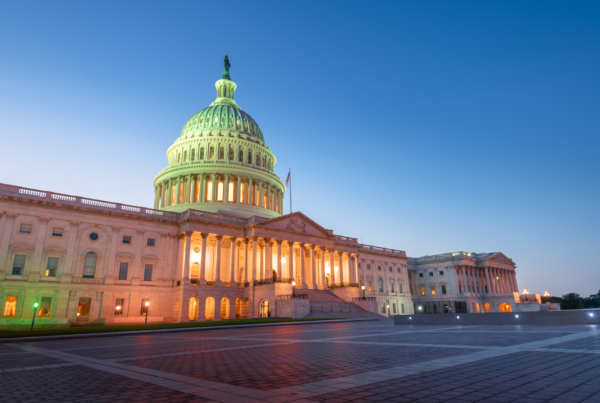(MIDDLETOWN, CT) February 22, 2023 – New research published by the Wesleyan Media Project provides two summaries of political advertising activity in the 2022 midterms. The two pieces appear in the latest issue of The Forum: A Journal of Applied Research in Contemporary Politics and are both freely available through open access. The first examines advertising trends on television across all sponsors (open access link) while the second hones in on digital activity on Meta (including Facebook and Instagram) and Google (including YouTube, display and search) by federal candidates (open access link).
Key takeaways from the publications are as follows:
- Television advertising
- 2022 featured a record volume of TV advertising for a midterm election.
- Pro-Democratic ads dominated television, continuing the trend from the 2018 and 2020 congressional elections.
- The issue agenda revolved around abortion and inflation, neither of which has been a big focus in prior election campaigns (at least as far back as 2000).
- Outside groups remained a dominant force with even more investment in U.S. House races in 2022 than seen in prior years.
- Digital advertising
- Candidates in federal races spent almost $150 million on digital ads, though Meta spending is down from 2020.
- Democrats, in general, spent more heavily on digital than did Republicans, but digital spending still pales in comparison to television spending in most competitive races.
- Some candidates focused their digital advertising on out-of-state fundraising, while others focused on speaking to in-state voters.
- Ads sponsored by federal candidates were more positive on Facebook and Instagram and contained less discussion of abortion and inflation compared to television.
Additional information on top issues in television ad in the fall general election period of the 2022 midterms is available in the tables below by race, which highlight that abortion was the top talking point for pro-Democratic advertising in both federal and gubernatorial airings on television. On the Republican side, pro-Republican airings were most likely to discuss issues of public safety in gubernatorial ads and discuss budget and government spending in federal races. For further discussion of what was and what was not featured in 2022 midterm advertising and its consequences for policy, see the following write-up by the Collaborative for Media & Messaging (COMM) for Health and Social Policy.
Table 1: Top Issues in Gubernatorial Races by Party Lean (General Election Only)
| Pro-Dem % | Pro-Rep % | ||
|---|---|---|---|
| Abortion | 40.6% | Public safety | 48.3% |
| Budget | 35.8% | Taxes | 42.4% |
| Education | 31.9% | Budget | 42.2% |
| Health care | 30.1% | Education | 30.1% |
| Women's rights | 26.9% | Jobs | 27.0% |
| Taxes | 26.0% | Economy | 26.0% |
| Public safety | 21.2% | Energy/environment | 20.5% |
| Jobs | 13.8% | Covid-19 | 19.5% |
| Economy | 12.8% | Inflation | 17.5% |
| Energy/environment | 9.2% | Immigration | 15.6% |
| Figures are from September 5 to November 8, 2022. Numbers include broadcast television for all sponsors. Cite source of data as: Kantar/CMAG with analysis by the Wesleyan Media Project. |
|||
Table 2: Top Issues in U.S. House Races by Party Lean (General Election Only)
| Pro-Dem % | Pro-Rep % | ||
|---|---|---|---|
| Abortion | 38.8% | Budget | 44.4% |
| Health care | 34.2% | Economy | 44.3% |
| Prescription drugs | 23.4% | Taxes | 41.2% |
| Public safety | 20.7% | Inflation | 40.2% |
| Budget | 19.0% | Energy/environment | 36.9% |
| Taxes | 15.0% | Public safety | 27.2% |
| Energy/environment | 12.5% | Immigration | 11.0% |
| Medicare | 12.1% | Jobs | 9.7% |
| Supreme Court | 12.0% | Corruption | 7.5% |
| Jobs | 11.6% | Utility rates | 6.4% |
| Figures are from September 5 to November 8, 2022. Numbers include broadcast television for all sponsors. Cite source of data as: Kantar/CMAG with analysis by the Wesleyan Media Project. |
|||
Table 3: Top Issues in U.S. Senate Races by Party Lean (General Election Only)
| Pro-Dem % | Pro-Rep % | ||
|---|---|---|---|
| Abortion | 26.9% | Budget | 46.0% |
| Health care | 23.9% | Public safety | 42.3% |
| Taxes | 16.4% | Taxes | 37.0% |
| Public Safety | 16.3% | Economy | 35.9% |
| Prescription drugs | 16.2% | Inflation | 34.5% |
| Jobs | 14.0% | Immigration | 24.4% |
| Social security | 12.7% | Energy/environment | 20.1% |
| Medicare | 12.0% | Drugs | 12.8% |
| Budget | 11.9% | Education | 9.2% |
| Trade | 11.1% | Covid-19 | 7.8% |
| Figures are from September 5 to November 8, 2022. Numbers include broadcast television for all sponsors. Cite source of data as: Kantar/CMAG with analysis by the Wesleyan Media Project. |
|||
Table 4: Top Issues in Federal Races by Party Lean (General Election Only)
| Pro-Dem % | Pro-Rep % | ||
|---|---|---|---|
| Abortion | 33.5% | Budget | 45.1% |
| Health care | 29.6% | Economy | 40.5% |
| Prescription drugs | 20.2% | Taxes | 39.3% |
| Public safety | 18.8% | Inflation | 37.7% |
| Budget | 15.9% | Public Safety | 34.0% |
| Taxes | 15.6% | Energy/environment | 29.3% |
| Jobs | 12.6% | Immigration | 17.0% |
| Medicare | 12.0% | Drugs | 8.4% |
| Social Security | 11.3% | Jobs | 8.3% |
| Supreme Court | 10.5% | Education | 6.5% |
| Figures are from September 5 to November 8, 2022. Numbers include broadcast television for all sponsors. Cite source of data as: Kantar/CMAG with analysis by the Wesleyan Media Project. |
|||
Additional geographic information on the prevalence of different issues in federal races during the general election period is available via our issue spotlight coverage.
About this Report
The Wesleyan Media Project provides real-time tracking and analysis of all political television advertising in an effort to increase transparency in elections. Housed in Wesleyan’s Quantitative Analysis Center – part of the Allbritton Center for the Study of Public Life – the Wesleyan Media Project is the successor to the Wisconsin Advertising Project, which disbanded in 2009. It is directed by Erika Franklin Fowler, professor of government at Wesleyan University, Michael M. Franz, professor of government at Bowdoin College and Travis N. Ridout, professor of political science at Washington State University. WMP personnel include Breeze Floyd (Research Coordinator), Pavel Oleinikov (Associate Director, QAC), Markus Neumann (Post-Doctoral Fellow), and Jielu Yao (Post-Doctoral Fellow).
Data are provided by Kantar/CMAG with analysis by the Wesleyan Media Project. The Wesleyan Media Project is partnering again this year with OpenSecrets, to provide added information on outside group disclosure and candidate status.
The Wesleyan Media Project’s digital advertising tracking is supported by the contributions of students in Delta Lab, an interdisciplinary research collaborative focusing on computationally-driven and innovative analyses and visualizations of media messaging.
Periodic releases of data will be posted on the project’s website and dispersed via Twitter @wesmediaproject. To be added to our email update list, click here.
For more information contact: media@wesleyan.edu.
About Wesleyan University
Wesleyan University, in Middletown, Conn., is known for the excellence of its academic and co-curricular programs. With more than 2,900 undergraduates and 200 graduate students, Wesleyan is dedicated to providing a liberal arts education characterized by boldness, rigor and practical idealism. For more, visit www.wesleyan.edu.




